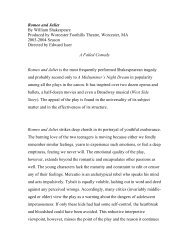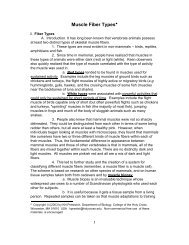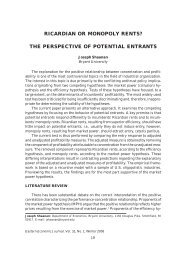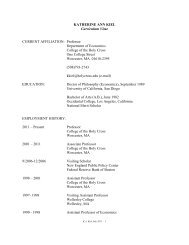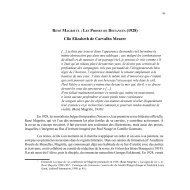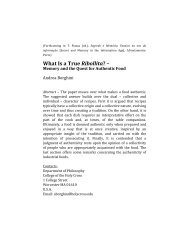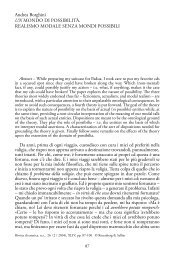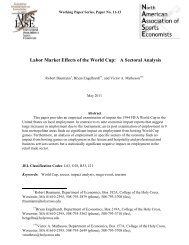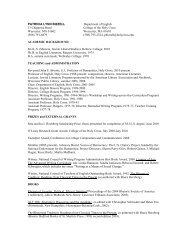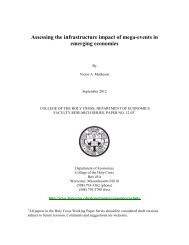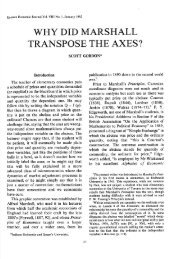29-2 Singh.pmd - College of the Holy Cross
29-2 Singh.pmd - College of the Holy Cross
29-2 Singh.pmd - College of the Holy Cross
You also want an ePaper? Increase the reach of your titles
YUMPU automatically turns print PDFs into web optimized ePapers that Google loves.
CAPITAL ACCOUNT LIBERALIZATION<br />
205<br />
<strong>Singh</strong>’s analysis also shows that <strong>the</strong> poor performance <strong>of</strong> industrialized countries<br />
during <strong>the</strong> 1980s and 1990s cannot alternatively be ascribed to exogenous factors<br />
such as <strong>the</strong> exhaustion <strong>of</strong> technological opportunities, or to labor market imperfections.<br />
Industrial economies have more flexible markets today than <strong>the</strong>y did in <strong>the</strong><br />
golden age. In addition <strong>the</strong>y have <strong>the</strong> benefit <strong>of</strong> a new technological paradigm <strong>of</strong><br />
information and communication technology which many economic historians regard<br />
as on a par with <strong>the</strong> most important technological revolutions <strong>of</strong> <strong>the</strong> last two centuries.<br />
In view <strong>of</strong> all <strong>the</strong>se factors—a new technological paradigm, more flexible markets,<br />
absence <strong>of</strong> economic shocks such as <strong>the</strong> oil shocks <strong>of</strong> 1973 and 1975—orthodox<br />
analyses would suggest that OECD economies should be growing today at a much<br />
faster rate than in <strong>the</strong> golden age. But as we see <strong>the</strong> opposite has been true.<br />
Eatwell’s [1996] and <strong>Singh</strong>’s [1997a] analyses indicate that <strong>the</strong> poor performance<br />
<strong>of</strong> industrial countries in <strong>the</strong> recent period is closely linked to intrinsic features <strong>of</strong> <strong>the</strong><br />
liberal financial regime. Coordination failures have led to suboptimal levels <strong>of</strong> <strong>the</strong><br />
OECD and world aggregate demand, output and employment. When capital flows<br />
were regulated in <strong>the</strong> 1950s and 1960s, and <strong>the</strong>re was successful coordination under<br />
<strong>the</strong> hegemony <strong>of</strong> <strong>the</strong> United States, balance <strong>of</strong> payments between countries was<br />
achieved at much higher levels <strong>of</strong> output and employment than has subsequently<br />
been <strong>the</strong> case under financial liberalization.<br />
In contrast with <strong>the</strong> above broad brush approach, <strong>the</strong>re exist numerous econometric<br />
studies <strong>of</strong> <strong>the</strong> effects <strong>of</strong> capital account liberalization on economic growth with<br />
definitely mixed results. Loungani recently reviewed <strong>the</strong> IMF contributions on <strong>the</strong><br />
subject and reached <strong>the</strong> following conclusion:<br />
…..What impact do capital flows have on growth? The evidence is<br />
decidedly mixed and appears to depend, somewhat, on <strong>the</strong> particular<br />
flow studied (or <strong>the</strong> measure <strong>of</strong> capital market openness used), <strong>the</strong><br />
sample period, <strong>the</strong> set <strong>of</strong> countries, and whe<strong>the</strong>r cross-section or panel<br />
data is used. Recent IMF work provides an illustration <strong>of</strong> mixed findings.<br />
In a much-cited study, Borensztein, De Gregorio, and Lee [1998]<br />
find that FDI increases economic growth when <strong>the</strong> level <strong>of</strong> education<br />
in <strong>the</strong> host country-a measure <strong>of</strong> its absorptive capacity- is high. Mody<br />
and Murshid [2002] find that capital inflows boost domestic investment<br />
almost one-to-one, but <strong>the</strong> strength <strong>of</strong> this relationship appears<br />
to be weakening over time. In contrast, Edison, Levine, Ricci, and<br />
Slok [2002], using <strong>the</strong> new measures <strong>of</strong> openness, do not find evidence<br />
<strong>of</strong> a robust link between international financial integration and<br />
economic growth. [2002, 6]<br />
Two main conclusions emerge from <strong>the</strong> above review <strong>of</strong> empirical evidence on<br />
capital account liberalization, financial crisis, and GDP growth. First, <strong>the</strong>re is strong<br />
evidence <strong>of</strong> a close relationship between liberalization and economic and financial<br />
crises in developing countries. This relationship is robust, and in <strong>the</strong> circumstances<br />
<strong>of</strong> <strong>the</strong>se countries <strong>the</strong>re are also strong analytical arguments for both its existence<br />
and robustness. Secondly, available evidence for <strong>the</strong> view that free capital flows promote<br />
faster long-term economic growth in developing countries is much weaker.



